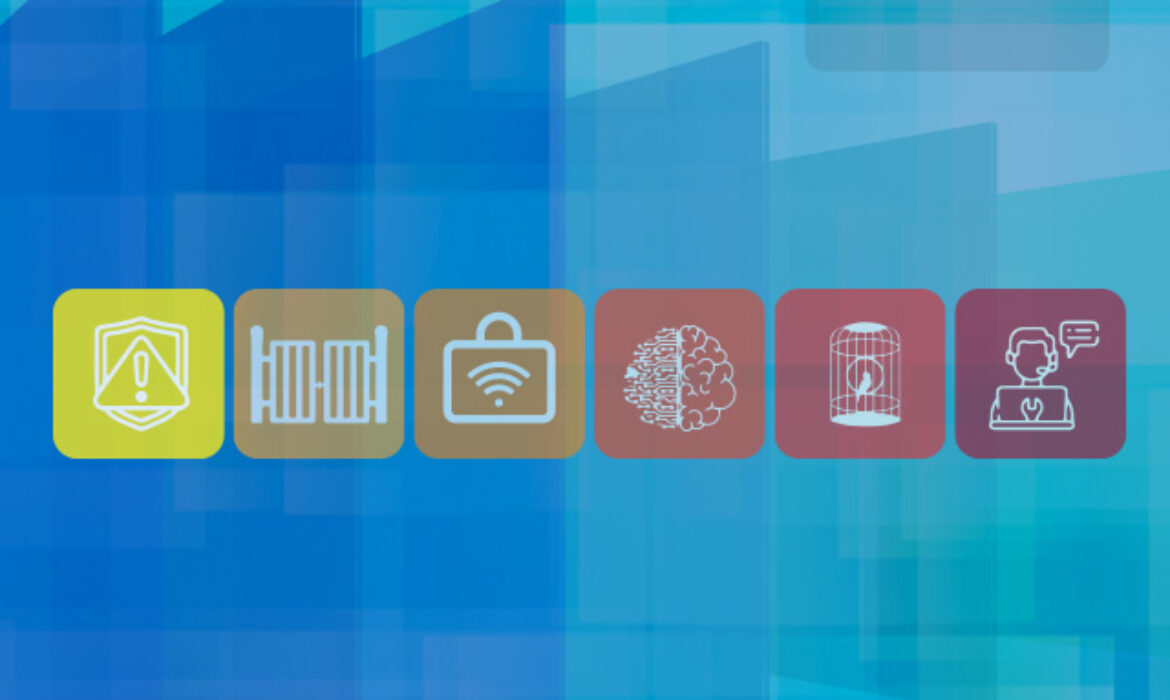Ensuring Comprehensive Protection
In today’s digitally driven world, safeguarding sensitive data and systems against cyber threats is paramount for businesses of all sizes. With cyberattacks becoming increasingly sophisticated and prevalent, adopting a multi-layered approach to cybersecurity is no longer optional—it’s imperative. In this article, we’ll delve into the six layers of cybersecurity defense that we employ and recommend that organizations implement to ensure comprehensive protection against cyber threats.
 Layer 1: IT Security Management
Layer 1: IT Security Management
At the core of any robust cybersecurity strategy lies efficient IT security management. This layer encompasses a suite of services, including firewall, gateway anti-virus, content filtering, and remote monitoring. These services work in tandem to provide comprehensive coverage across all aspects of your IT infrastructure, including equipment, software, and subscriptions. Endpoint security measures are also implemented to protect all servers and workstations from potential threats.
Recent statistics from the Cybersecurity and Infrastructure Security Agency (CISA), show 68% of business leaders feel their cybersecurity risks are increasing. Moreover, 43% of cyberattacks target small businesses. This highlights the critical need for organizations to invest in comprehensive IT security management solutions.
 Layer 2: Next-Generation Firewall
Layer 2: Next-Generation Firewall
Next-generation firewalls (NGFWs) offer advanced features and capabilities designed to combat modern cyber threats effectively. These high-performance firewalls provide multi-layered protection by analyzing incoming and outgoing traffic, identifying and blocking malicious content, and preventing unauthorized network access. Intrusion Prevention Systems (IPS) further enhance security by continuously monitoring and blocking suspicious activities in real-time.
So, what is a next-generation firewall? Imagine your computer network is like a fortress, and a firewall is like a security guard for hire, looking for suspicious activity, but not incredibly thorough. Traditional firewalls are like security guards that only check who’s coming in and out based on simple rules, like looking at the address of the sender or recipient of data.
Now, a next-generation firewall is like a TSA or customs agent, way more suspicious and thorough. It not only checks who’s coming in and out but also looks at what they’re carrying and what they’re doing. It can inspect the data packets—like small bundles of information—as they pass through the gate. It can spot suspicious behavior or patterns that might indicate an attack, like someone trying to sneak in disguised as a trusted visitor or trying to send harmful messages.
So, in simple terms, a next-generation firewall is a highly trained, more invested version of the traditional firewall. It’s better at spotting and stopping cyber threats because it can analyze data more deeply and understand more about what’s happening on your network.
According to a study by Gartner, the global NGFW market is projected to reach $5.3 billion by 2025, driven by the increasing demand for advanced threat protection. This underscores the importance of integrating NGFWs into your cybersecurity architecture.
 Layer 3: Managed and Secure WiFi
Layer 3: Managed and Secure WiFi
In today’s mobile-centric environment, secure WiFi networks are essential for maintaining a productive and connected workforce. Managed WiFi solutions offer cloud-based networks accessible via multiple access points, ensuring seamless connectivity across your organization. These solutions can handle numerous devices simultaneously while providing robust security features to protect against unauthorized access and potential threats.
Research from IDC reveals that by 2027, the number of IoT devices connected to enterprise networks will exceed 29 billion. With the proliferation of IoT devices, the importance of secure WiFi networks becomes even more critical in preventing cyber intrusions.
 Layer 4: AI Security Analysis
Layer 4: AI Security Analysis
Artificial Intelligence (AI) plays a pivotal role in enhancing cybersecurity defenses by analyzing vast amounts of data to identify patterns and anomalies indicative of potential threats. AI-powered security analysis tools can detect and mitigate cyber threats in real-time, generating actionable reports to assist human internal security teams in remediation efforts. The synergy between AI and human security analysis further strengthens defense mechanisms, providing organizations with proactive protection against evolving threats.
Capgemini Research Institute found that 61% of enterprises agree that AI is the cornerstone of their cybersecurity strategy. By harnessing the power of AI, organizations can stay one step ahead of cyber adversaries and mitigate risks effectively.
 Layer 5: Endpoint Protection
Layer 5: Endpoint Protection
Endpoints represent vulnerable entry points for cyberattacks, making endpoint protection a critical component of any cybersecurity strategy. Deploying ”canaries” for rapid ransomware detection and implementing endpoint security measures upon file modification can help organizations detect and respond to threats in real-time. Immediate alerting of security teams ensures swift action, minimizing the impact of potential breaches on business operations.
The average cost of a data breach in 2023 was $4.45 million, according to the Ponemon Institute’s Cost of a Data Breach Report. Investing in robust endpoint protection solutions can significantly reduce the financial and reputational repercussions of a cyber incident.
 Layer 6: Backup and Disaster Recovery
Layer 6: Backup and Disaster Recovery
Despite proactive security measures, organizations must prepare for the possibility of cyber incidents and data loss. Backup and disaster recovery solutions provide a safety net by ensuring the encrypted backup of data both locally and in the cloud. Stand-by servers facilitate business continuity in the event of a disruption, while regular management and verification of backups by a dedicated team minimize the risk of data loss and downtime.
According to a survey by IBM, organizations that can restore operations within 24 hours of a disaster are twice as likely to survive a data breach. Implementing robust backup and disaster recovery strategies is essential for mitigating the impact of cyber incidents and maintaining business continuity.
Conclusion:
In conclusion, adopting a multi-layered approach to cybersecurity is essential for safeguarding against evolving cyber threats. Each layer, from IT security management to backup and disaster recovery, plays a crucial role in ensuring comprehensive protection for organizations of all sizes. By investing in robust cybersecurity solutions and staying vigilant against emerging threats, businesses can mitigate risks effectively and safeguard their assets, reputation, and future success.
—–
Ready to enhance your organization’s cybersecurity posture? Contact your local technology consultant to learn more about our comprehensive cybersecurity services and how a layered approach can benefit your business. Don’t wait until it’s too late—prioritize cybersecurity and protect what matters most.
A lot of our clients have shown interest in cybersecurity training, and we have been paying attention! We are thrilled to announce that we now provide this service and training to help keep employees sharp and at the top of their game. It is available as an add-on option.

